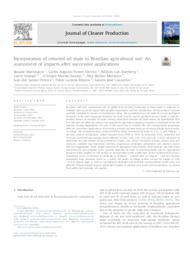Incorporation of retorted oil shale in Brazilian agricultural soil: An assessment of impacts after successive applications.
Incorporation of retorted oil shale in Brazilian agricultural soil: An assessment of impacts after successive applications.
Author(s): MARTINAZZO, R.; SILVEIRA, C. A. P.; BAMBERG, A. L.; STUMPF, L.; STOCKER, C. M.; MONTEIRO, A. B.; PEREIRA, I dos S.; RIBEIRO, P. L.; GIACOMINI, S. J.
Summary: Brazilian soils have unequivocal role on global food security. Production in these lands is subjected to multiple and successive inputs with variable composition, and the introduction of new products must be carefully validated to ensure environmental safety. The pyrobituminous oil shale from Irati geological formation is the most important Brazilian oil shale reserve, and its pyrolysis process yields a solid by-product known as retorted oil shale. Among alternative retorted oil shale reuses we hypothesize that it is safe and can either be used as raw material for agricultural inputs production or disposed in the soil without causing degradation. The aim of this work was to evaluate the soil contamination propensity after six cumulative applications of increasing retorted oil shale doses on an Arenic Rhodic Acrisol under no-tillage. The treatments were composed of four doses of retorted oil shale (0, 0.75, 1.5 and 3?Mg?ha?1) all with mineral fertilization, added annually from 2009 to 2014. In November 2015, disturbed and structure preserved soil samples were collected in 0.00?0.05, 0.05?0.10 and 0.10?0.20?m soil layers to determine the total content of trace elements (copper, zinc, nickel, chromium, barium, arsenic, lead and mercury), available macronutrients (calcium, magnesium, potassium, phosphorus and sulphur), macro and microaggregates, mean weight diameter of aggregates, bulk density, total porosity, macroporosity, microporosity and available water capacity. Retorted oil shale is environmentally safe for agricultural purposes when applied on soil surface or incorporated in the arable layer. In the medium term (6-yrs) cumulative doses of retorted oil shale up to 18?Mg?ha?1 (annual dose of 3?Mg?ha?1) did not increase potentially toxic elements levels in a sandy soil under no-tillage system, except for copper at 0.00?0.05?m topsoil layer as well as soil physical attributes and available macronutrients levels were not affected. Policies should require robust field studies to validate new waste-derived products, to ensure food safety and maintain soil quality.
Publication year: 2020
Types of publication: Journal article
Keywords: Contaminação, Segurança ambiental, Solo, Xisto
Observation
Some of Embrapa's publications are published as ePub files. To read them, use or download one of the following free software options to your computer or mobile device. Android: Google Play Books; IOS: iBooks; Windows and Linux: Calibre.
Access other publications
Access the Agricultural Research Database (BDPA) to consult Embrapa's full library collection and records.
Visit Embrapa Bookstore to purchase books and other publications sold by Embrapa.

